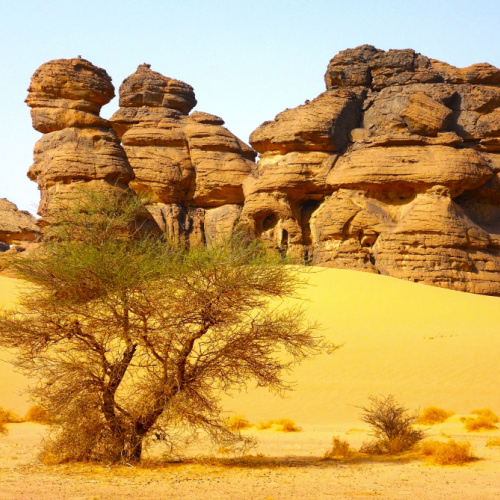
evgenii mitroshin/Shutterstock
When Is the Best Time to Visit Chad?
The best time to visit Chad is during the dry season, which runs from November to May. During this time, the weather is mild and sunny, with less rainfall and humidity. This makes it ideal for game viewing, outdoor activities, and sightseeing.
Here is a more detailed breakdown of the best time to visit Chad, according to region:
- North Chad: The best time to visit northern Chad is during the dry season, from November to April. During this time, the weather is mild and sunny, with less rainfall and humidity. This makes it ideal for game viewing in Zakouma National Park, one of the best places in Africa to see elephants, lions, and leopards.
- Central Chad: The best time to visit central Chad is also during the dry season, from November to April. During this time, the weather is mild and sunny, with less rainfall and humidity. This makes it ideal for visiting the Ennedi Natural and Cultural Reserve, a UNESCO World Heritage Site known for its stunning desert landscapes and prehistoric rock art.
- Southern Chad: The best time to visit southern Chad is during the dry season, from November to March. During this time, the weather is mild and sunny, with less rainfall and humidity. This makes it ideal for visiting the Chari River Basin, a fertile region known for its lush vegetation and wildlife.
 Average Temperatures by Month
Average Temperatures by Month
|
Jan |
Feb |
Mar |
Apr |
May |
Jun |
Jul |
Aug |
Sep |
Oct |
Nov |
Dec |
| Fahrenheit |
73°
|
79°
|
90°
|
97°
|
100°
|
93°
|
84°
|
82°
|
86°
|
90°
|
82°
|
75°
|
| Celsius |
23°
|
26°
|
32°
|
36°
|
38°
|
34°
|
29°
|
28°
|
30°
|
32°
|
28°
|
24°
|
Climate in Chad
Summer Season in Chad
The summer season in Chad, occurring from June to August, brings scorching temperatures often exceeding 100°F. It's a challenging time for outdoor activities, and visitors should be prepared for intense heat. The Sahara Desert regions of Chad experience some of the hottest conditions. While this season may not be ideal for extensive exploration, it can be an opportunity to immerse yourself in the local culture and traditions.
Rainy Season in Chad
had's rainy season falls between June and September, with the heaviest rainfall in July and August. During this period, the temperatures range from 75°F to 90°F. It's the time when the country's arid areas turn lush and green, making it suitable for wildlife enthusiasts and those keen to explore Chad's natural beauty.
Winter Season in Chad
The winter months, from December to February, offer milder and more comfortable temperatures, ranging from 68°F to 86°F. This is the ideal time for exploring Chad's stunning natural landscapes, including national parks and desert oases. It's also a more pleasant period for cultural exploration and visiting historical sites. In the desert regions, winter is the prime time for camel trekking and Sahara adventures.
Our Recommendations
| Destination |
Jan |
Feb |
Mar |
Apr |
May |
Jun |
Jul |
Aug |
Sep |
Oct |
Nov |
Dec |
| Chad |
 |
 |
 |
 |
 |
 |
 |
 |
 |
 |
 |
 |






